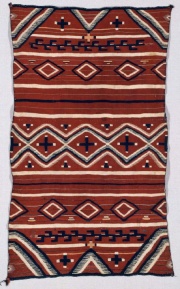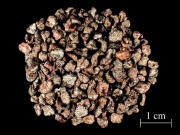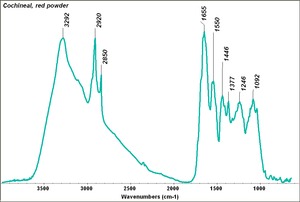Difference between revisions of "Cochineal"
| (3 intermediate revisions by the same user not shown) | |||
| Line 3: | Line 3: | ||
A natural, bright red dye obtained from the body of the female insects ''Dactylopius coccus'' Costa (formerly ''Coccus cacti'') that live on nopal cactus (''Cactus oputia'' or ''C. coccinilifera'') in Mexico, the Canary Islands, and in Central and South America. Cochineal was imported to Europe as early as 1540 where it quickly replaced kermes as the primary red dyestuff. The insects are collected from the cacti, then killed and dried in the sun or in an oven. The dye is extracted from dried insects using water or alcohol. It contains about 10% [[carminic acid]], 2% coccerin wax and 10% fat. The colorant was usually used as either a red solution or precipitated to make [[carmine lake|carmine]], an aluminum or aluminum-tin lake. Cochineal produces a transparent lake pigment that has poor lightfastness and fades in strong sunlight. | A natural, bright red dye obtained from the body of the female insects ''Dactylopius coccus'' Costa (formerly ''Coccus cacti'') that live on nopal cactus (''Cactus oputia'' or ''C. coccinilifera'') in Mexico, the Canary Islands, and in Central and South America. Cochineal was imported to Europe as early as 1540 where it quickly replaced kermes as the primary red dyestuff. The insects are collected from the cacti, then killed and dried in the sun or in an oven. The dye is extracted from dried insects using water or alcohol. It contains about 10% [[carminic acid]], 2% coccerin wax and 10% fat. The colorant was usually used as either a red solution or precipitated to make [[carmine lake|carmine]], an aluminum or aluminum-tin lake. Cochineal produces a transparent lake pigment that has poor lightfastness and fades in strong sunlight. | ||
| − | + | [[File:cochineal_dried bodies_1.jpg|thumb|Dried cochineal (''Dactylopius coccus Costa'')]] | |
| − | [[File:cochineal_dried bodies_1.jpg|thumb|Dried cochineal | + | * See also [[http://cameo.mfa.org/wiki/Category:Uemura_dye_archive '''Uemera Dye Archive''' (Enjimushi)]] and [[http://cameo.mfa.org/wiki/Category:Natural_Dyes '''Dye Analysis''' (Cochineal)]] |
| − | |||
| − | (''Dactylopius coccus Costa'')]] | ||
== Synonyms and Related Terms == | == Synonyms and Related Terms == | ||
| Line 25: | Line 23: | ||
* Analytical strategies for natural dyestuffs in cultural heritage objects - EU-ARTECH European research project - http://www.organic-colorants.org | * Analytical strategies for natural dyestuffs in cultural heritage objects - EU-ARTECH European research project - http://www.organic-colorants.org | ||
| − | |||
| − | |||
== Additional Images == | == Additional Images == | ||
| Line 39: | Line 35: | ||
== Sources Checked for Data in Record == | == Sources Checked for Data in Record == | ||
| − | * R. J. Gettens, G.L. Stout, ''Painting Materials, A Short Encyclopaedia'', Dover Publications, New York, 1966 Comment: came | + | * R. J. Gettens, G.L. Stout, ''Painting Materials, A Short Encyclopaedia'', Dover Publications, New York, 1966 Comment: came to Europe after the conquest of Mexico in 1523 |
* Helmut Schweppe, Schweppe color collection index and information book | * Helmut Schweppe, Schweppe color collection index and information book | ||
| Line 63: | Line 59: | ||
* Thomas B. Brill, ''Light Its Interaction with Art and Antiquities'', Plenum Press, New York City, 1980 | * Thomas B. Brill, ''Light Its Interaction with Art and Antiquities'', Plenum Press, New York City, 1980 | ||
| − | * ''Encyclopedia Britannica'', http://www.britannica.com "Cochineal." | + | * ''Encyclopedia Britannica'', http://www.britannica.com "Cochineal." 15 Apr. 2004 . |
* G.S.Brady, ''Materials Handbook'', McGraw-Hill Book Co., New York, 1971 Comment: p. 208 | * G.S.Brady, ''Materials Handbook'', McGraw-Hill Book Co., New York, 1971 Comment: p. 208 | ||
Revision as of 16:38, 30 June 2020
Description
A natural, bright red dye obtained from the body of the female insects Dactylopius coccus Costa (formerly Coccus cacti) that live on nopal cactus (Cactus oputia or C. coccinilifera) in Mexico, the Canary Islands, and in Central and South America. Cochineal was imported to Europe as early as 1540 where it quickly replaced kermes as the primary red dyestuff. The insects are collected from the cacti, then killed and dried in the sun or in an oven. The dye is extracted from dried insects using water or alcohol. It contains about 10% Carminic acid, 2% coccerin wax and 10% fat. The colorant was usually used as either a red solution or precipitated to make carmine, an aluminum or aluminum-tin lake. Cochineal produces a transparent lake pigment that has poor lightfastness and fades in strong sunlight.
- See also [Uemera Dye Archive (Enjimushi)] and [Dye Analysis (Cochineal)]
Synonyms and Related Terms
Natural Red 4; CI 75470; cochenille (Fr.); Cochenille (Deut.); cocciniglia (It.); cochinilla (Esp.); Nopalschildlaus (Deut.); Koschenille (Deut.); Karmin (Deut.); kogchinili (Gr.); cocciniglia (It.); cochenille (Ned.); cochonilha (Port.); cochinilha (Port.); carmine; crimson lake; grana; purple lake; red lake; Florentine lake; Venice lake; Paris lake; Vienna lake; nochestli; Nupal's blood; globe lake, karmesin lake; Munich lake; metica; mestique; grana finia; grana silvestra; zacatilla (black cochineal); Dactylopius coccus; Coccus cacti
Physical and Chemical Properties
Acid-base indicator: a 1% alcohol solution is red when acidic and changes to violet above pH 6.
ASTM (1999) lightfastness = V (very poor)
Additional Information
- H. Schweppe, H.Roosen-Runge, "Carmine-Cochineal, Carmine and Kermes Carmine", Artists Pigments, Volume 1, R. Feller (ed.), Cambridge University Press: Cambridge, 1986.
- Analytical strategies for natural dyestuffs in cultural heritage objects - EU-ARTECH European research project - http://www.organic-colorants.org
Additional Images
Sources Checked for Data in Record
- R. J. Gettens, G.L. Stout, Painting Materials, A Short Encyclopaedia, Dover Publications, New York, 1966 Comment: came to Europe after the conquest of Mexico in 1523
- Helmut Schweppe, Schweppe color collection index and information book
- Ralph Mayer, A Dictionary of Art Terms and Techniques, Harper and Row Publishers, New York, 1969 (also 1945 printing) Comment: imported from Mexico as early as 1560.
- Palmy Weigle, Ancient Dyes for Modern Weavers, Watson-Guptill Publications, New York, 1974 Comment: dye brought to Europe in the early 16th century
- Judith Hofenk-de Graaff, Natural Dyestuffs: Origin, Chemical Constitution, Identification, Central Research Laboratory for Objects of Art and Science, Amsterdam, 1969 Comment: imported in 1540 to Antwerp
- J. Thornton, 'The Use of Dyes and Colored Varnishes in Wood Polychromy', Painted Wood: History and Conservation, The Getty Conservation Insitute, Los Angeles, 1998
- Hermann Kuhn, Conservation and Restoration of Works of Art and Antiquities, Butterworths, London, 1986
- S.R.Trotman, E.R. Trotman, Textile Analysis, J.B. Lippincott Company, Philadelphia, 1932
- F. H. Titmuss, Commercial Timbers of the World, The Technical Press Ltd., London, 1965
- Matt Roberts, Don Etherington, Bookbinding and the Conservation of Books: a Dictionary of Descriptive Terminology, U.S. Government Printing Office, Washington DC, 1982
- R. Newman, E. Farrell, 'House Paint Pigments', Paint in America , R. Moss ed., Preservation Press, New York City, 1994
- Thomas B. Brill, Light Its Interaction with Art and Antiquities, Plenum Press, New York City, 1980
- Encyclopedia Britannica, http://www.britannica.com "Cochineal." 15 Apr. 2004 .
- G.S.Brady, Materials Handbook, McGraw-Hill Book Co., New York, 1971 Comment: p. 208
- Richard S. Lewis, Hawley's Condensed Chemical Dictionary, Van Nostrand Reinhold, New York, 10th ed., 1993
- Random House, Webster's Encyclopedic Unabridged Dictionary of the English Language, Grammercy Book, New York, 1997
- The Merck Index, Martha Windholz (ed.), Merck Research Labs, Rahway NJ, 10th edition, 1983
- Book and Paper Group, Paper Conservation Catalog, AIC, 1984, 1989
- Website address 1 Comment: www.handprint.com
- Art and Architecture Thesaurus Online, http://www.getty.edu/research/tools/vocabulary/aat/, J. Paul Getty Trust, Los Angeles, 2000






